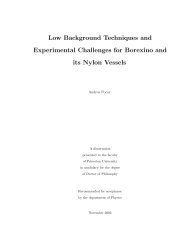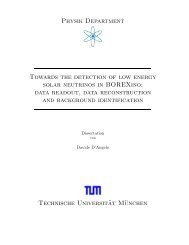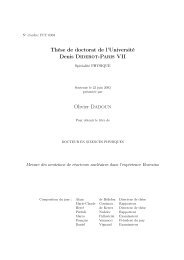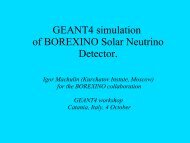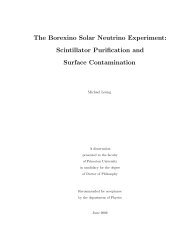Development of a Liquid Scintillator and of Data ... - Borexino - Infn
Development of a Liquid Scintillator and of Data ... - Borexino - Infn
Development of a Liquid Scintillator and of Data ... - Borexino - Infn
Create successful ePaper yourself
Turn your PDF publications into a flip-book with our unique Google optimized e-Paper software.
5 Particle Identification with a Neural Network<br />
5.3 Results<br />
5.3.1 Simulated <strong>Data</strong><br />
In a Monte Carlo simulation, 20 000 alpha <strong>and</strong> beta events were generated all over the Inner<br />
Vessel, with r<strong>and</strong>om energies from 0 to 3 MeV. Fig. 5.6 shows a typical simulated alpha <strong>and</strong> a<br />
beta pulse for the CTF2 geometry. The time spectrum recorded was binned in such a way to<br />
reproduce the flash ADC output (2.5 ns sampling time, 8 bit depth).<br />
The input values for the NN were:<br />
- 100 bins <strong>of</strong> the normalized flash ADC spectrum (250 ns);<br />
- the radial distance from the center (reconstructed position), normalized to the Inner<br />
Vessel radius;<br />
- the energy <strong>of</strong> the event, in MeV.<br />
The NN had 102 neurons in the input layer, 102 neurons in the hidden layer, <strong>and</strong> 1 neuron in<br />
the output layer, giving ¢ weights Û. The output parameter <strong>of</strong> the<br />
net is called nn¬ <strong>and</strong> can take values between 0 <strong>and</strong> 1. Ideally it should be 1 for beta events<br />
<strong>and</strong> 0 for alpha events. If nn¬ is between 0 <strong>and</strong> 0.5, the event is classified as alpha event; if<br />
nn¬ is larger than 0.5, the event is classified as beta event. The training set consisted <strong>of</strong> 8000<br />
events. After each 10 events the weights were updated using the backpropagation algorithm.<br />
The validation set consisted <strong>of</strong> 8000 events (different from the training set). The results <strong>of</strong><br />
the NN after 5000 generations are shown in in fig. 5.7 for events with energies greater than<br />
0.2 MeV. From 3629 beta events only 46 were misidentified as alpha events. From 3607 alpha<br />
events 42 were misidentified as beta events. This means, that for 98.7 % beta identification<br />
efficiency, 98.8 % <strong>of</strong> the alpha events are rejected.<br />
For a comparison I also calculated the tail-total-ratio from the flash ADC spectrum with the<br />
tail starting after 47.5 ns (see fig. 5.8). For the same beta identification efficiency (98.7 %) with<br />
this method, I also got the same alpha rejection efficiency (98.8 %).<br />
The neural network has the same discrimination capability as the st<strong>and</strong>ard tail-to-total ratio,<br />
but it cannot beat this simpler <strong>and</strong> more straightforward technique.<br />
68



